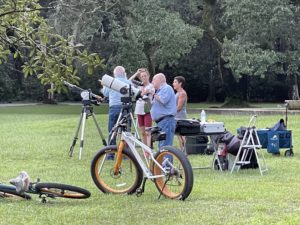Our first state park public star gaze of 2021 was a success. We can honestly say that the new guidelines we have to work under did not hamper the event one bit. Attendance was down a little for Eden Gardens at 35-40 guest observers but it was nice to see quite a few families getting a chance to view the heavens under fairly dark skies.
The early birds got to see a daytime Venus. Unfortunately, it quickly dropped below Eden Garden’s high tree line. Luckily, a near 4 day old moon showed a nice daytime crescent and was visible long enough for the sky to darken bringing Jupiter in to view. After that Saturn quickly followed. Along with some constellation identification and mythology stories, deep sky objects such as M 11, M 13 and M 47 were viewed. Lyra’s double double star system as well as Ursa Major’s Alcor/Mizar system were also observed and discussed. Toward the end of the evening some high thin clouds started to brighten the sky but by then most of the guests had headed towards the parking lot.
We had three members support the event: Walter Dunn, Tom Haugh and Dennis Hausch. In addition to each of their scopes we had also set up a library scope for the guests to use on their own and one guest bring her own scope to add to the fun. So, all in all, we had 5 scopes pointed at the sky.
We would like to thank the Florida State Park system for creating a set of guidelines that worked for everyone allowing us to resume our passion for sharing the night sky. We also want to thank Eden Gardens State Park for their invitation and support. We also thank Marietta Hausch for her event photographs.




















